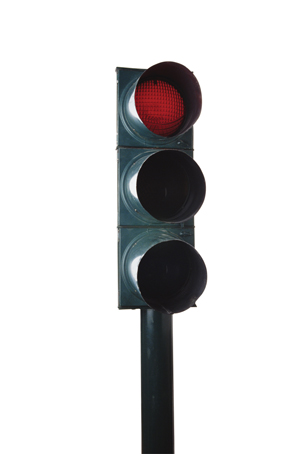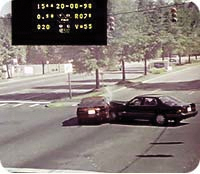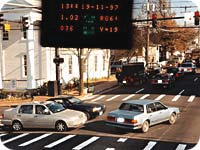 RED LIGHT CAMERAS • Q&A'S
RED LIGHT CAMERAS • Q&A'S RED LIGHT CAMERAS • Q&A'S
RED LIGHT CAMERAS • Q&A'S
Insurance Institute for Highway Safety
The following data was accumulated and examined by the Insurance Institute for Highway Safety in 2010 and published in February 2011. It is the most current report available on red light cameras.
Q&As, which address frequently asked questions about highway safety, are updated continuously by the Insurance Institute for Highway Safety as relevant information is acquired.
1. Why do we need red light cameras?
Red light runners cause hundreds of deaths and tens of thousands of injuries each year. In 2009, 676 people were killed and an estimated 130,000 were injured in crashes that involved red light running. About half of the deaths in red light running crashes are pedestrians, bicyclists, and occupants in other vehicles who are hit by the red light runners.
An Institute study of urban crashes found that those involving drivers who ran red lights, stop signs and other traffic controls were the most common type of crash (22 percent). Injuries occurred in 39 percent of the crashes in which motorists ran traffic controls.

Red light running crash
Enforcement is the key to getting people to comply with a law, but communities don't have the resources to allow police to patrol intersections as often as would be needed to ticket all motorists who run red lights. Studies have shown that the presence of cameras reduces red light running.
2. How is red light running defined?
If a vehicle enters an intersection any time after the signal light has turned red the driver has committed a violation. Motorists inadvertently in an intersection when the signal changes, waiting to turn left for example, are not red light runners. In locations where a right turn on red is permitted drivers who fail to come to a complete stop before turning may be considered red light runners. However, communities differ as to whether they issue tickets for it when it is caught on camera.
3. How often do drivers run red lights?
A study conducted during several months at 5 busy intersections in Fairfax, Virginia prior to the use of red light cameras found that, on average, a motorist ran a red light every 20 minutes at each intersection. During peak travel times red light running was more frequent. Analysis of red light violation data from 19 intersections without red light cameras in 4 states found that 1,775 violations occurred over 554 hours for a violation rate of 3.2 per hour per intersection.
In a 2010 telephone survey by the AAA Foundation for Traffic Safety 93 percent of drivers said it's unacceptable to go through a red light if it's possible to stop safely, but one-third reported doing so in the past 30 days.
4. What kinds of drivers are most likely to run red lights?
A 1996 Institute study of red light runners at one Arlington, Virginia, intersection found that, as a group, they were younger, were less likely to use safety belts, and had poorer driving records than drivers who stopped for red lights. Red light runners were more than three times as likely to have multiple speeding convictions on their driver records. No gender differences were found between violators and drivers who did not run red lights.
An Institute analysis of 2009 fatal red light running crashes compared the red light runners with the drivers involved in these crashes who did not run the red. The red light runners were more likely to be under 30 and male and to have prior crashes, alcohol impaired driving convictions, and citations for speeding and other moving violations. The red light runners also were more likely to be speeding or alcohol impaired at the time of the crash, and less likely to have a valid driver's license
5. How do red light cameras work?
Red light cameras automatically photograph vehicles whose drivers run red lights. The cameras are connected to the traffic signal and to sensors that monitor traffic flow just before the crosswalk or stop line. The system continuously monitors the traffic signal, and the camera captures any vehicle that doesn't stop during the red phase. Many red light camera programs provide motorists with grace periods of up to half a second after the light switches to red.
Depending on the particular technology, a series of photographs and/or a video clip shows the red light violator prior to entering the intersection on a red signal as well as the vehicle's progression through the intersection. Cameras record the date, time of day, time elapsed since the beginning of the red signal, vehicle speed, and license plate. Tickets typically are mailed to owners of violating vehicles based on a review of photographic evidence.
6. Isn't conventional police enforcement sufficient?
Police can't be everywhere at once, and red light cameras allow officers to focus on other enforcement needs.
Moreover, enforcing traffic laws in dense urban areas by traditional means poses special difficulties for police who, in most cases, must follow a violating vehicle through a red light to stop it. This can endanger motorists and pedestrians as well as officers. Traffic stops in urban areas also can exacerbate traffic congestion.

Red light camera violation photo
7. What safety benefits do red light cameras provide?
A 2011 Institute study comparing large cities with red light cameras to those without found the devices reduced the fatal red light running crash rate by 24 percent and the rate of all types of fatal crashes at signalized intersections by 17 percent.
Previous research has shown that cameras substantially reduce red light violations and crashes. Studies by the Institute and others have found reductions ranging from 40 to 96 percent after the introduction of cameras. Institute studies in Fairfax, Virginia, and Oxnard, California found that, in addition to the decrease in red light running at camera equipped sites, the effect carried over to signalized intersections not equipped with red light cameras indicating community wide changes in driver behavior.
In Oxnard, significant citywide crash reductions followed the introduction of red light cameras, and injury crashes at intersections with traffic signals were reduced by 29 percent. Front into side collisions – the crash type most closely associated with red light running – at these intersections declined by 32 percent overall, and front into side crashes involving injuries fell 68 percent.
An Institute review of international red light camera studies concluded that cameras lower red light violations by 40-50 percent and reduce injury crashes by 25-30 percent.
8. Don't red light cameras encourage drivers to stop short increasing the risk of a rear end collision?
Some studies have reported that while red light cameras reduce front into side collisions and overall injury crashes they can increase rear end crashes. However, such crashes tend to be much less severe than front into side crashes so the net effect is positive.
A study sponsored by the Federal Highway Administration evaluated red light camera programs in 7 cities. The study found that, overall, right angle crashes decreased by 25 percent while rear end collisions increased by 15 percent. Results showed a positive aggregate economic benefit of more than $18.5 million in the 7 communities. The authors concluded that the economic costs from the increase in rear end crashes were more than offset by the economic benefits from the decrease in right angle crashes targeted by red light cameras.
Not all studies have reported increases in rear end crashes. The Cochrane Collaboration, an international public health organization, reviewed 10 controlled before-after studies of red light camera effectiveness. Based on the most rigorous studies there was an estimated 13-29 percent reduction in all types of injury crashes and a 24 percent reduction in right angle injury crashes. The review did not find a statistically significant change in rear end injury crashes.
9. Isn't longer yellow signal timing more effective than using red light cameras to reduce red light running?
Providing adequate yellow time and a brief phase when all signals are red is important and can reduce crashes, but those things alone don't eliminate the need for or potential benefits of red light cameras. Studies have shown that increasing
yellow timing to values associated with guidelines published by the Institute of Transportation Engineers can significantly decrease the frequency of red light violations. In addition, a 2002 Institute study found that injury crashes at urban intersections fell 12 percent after the yellow and all red traffic signal timing was modified according to ITE guidelines.
An Institute study conducted in Philadelphia, Pennsylvania evaluated effects on red light running by first lengthening yellow signal timing by about a second and then introducing red light cameras. While the longer yellow reduced red light violations by 36 percent adding camera enforcement further cut red light running by another 96 percent.
10. Can anything else be done to reduce the number of red light running crashes?
Signalized intersections can be replaced altogether by roundabouts which have dramatically fewer injury crashes. However, it's not feasible to replace every traffic light with a roundabout, and not every intersection is appropriate for a roundabout. Better enforcement of traffic signals using cameras is a solution that can quickly be implemented on a large scale.
11. Does someone review the photographs before motorists are ticketed?
Yes. It is standard practice for trained police officers or other officials to review every picture to verify vehicle information and ensure the vehicle is in violation. A ticket is issued only if there is clear evidence the vehicle ran a red light.
12. Do red light cameras violate motorists' privacy?
No. Driving is a regulated activity on public roads. By obtaining a license a motorist agrees to abide by certain rules such as to obey traffic signals. Neither the law nor common sense suggests drivers should not be observed on the road or have their violations documented. Red light camera systems can be designed to photograph only a vehicle's rear license plate and not vehicle occupants although in some places the law requires a photograph of the driver.
13. Are special laws needed to allow localities to use red light cameras to cite violators?
Before cameras may be used state or local laws must authorize enforcement agencies to cite red light violators by mail. The legislation makes the vehicle owner responsible for the ticket. In most cases this involves establishing a presumption that the registered owner is the vehicle driver at the time of the offense and providing a mechanism for vehicle owners to inform authorities if someone else was driving.
Another option is to treat violations captured by red light cameras as the equivalent of parking tickets. If, as in New York, red light camera violations are treated like parking citations the law can make registered vehicle owners responsible without regard to who was driving at the time of the offense.
Red light cameras currently are authorized in about half of US states.
14. Isn't the main purpose of red light cameras to make money?
No. The objective of photo enforcement is to deter violators not to catch them. Signs and publicity campaigns typically warn drivers that photo enforcement is in use. Revenue is generated from fines paid by drivers who continue to run red lights, but this is a fundamental component of all traffic enforcement programs. Ideally, ticket revenue should decline over time as the cameras succeed in deterring would be red light runners. Independent audits of red light camera enforcement have shown that in some jurisdictions fines exceeded program costs while, in others, the programs didn't break even.
15. Does the American public support the use of red light cameras?
Like other government policies and programs camera enforcement requires acceptance and support among the public as well as elected leaders. Some opponents of automated enforcement raise the "big brother" issue to stir up disapproval, and voters in a few cities have rejected cameras.
Still, acceptance of cameras always has been strong. A 2000 Institute survey conducted in 10 US cities, 5 with red light cameras and 5 without, found more than 75 percent of drivers supported the cameras. A 2002 nationwide survey sponsored by the National Highway Traffic Safety Administration also found favor among 75 percent of drivers. In a survey by the Virginia Transportation Research Council at 6 locations in the state almost 2 of 3 respondents supported red light cameras.
16. Which US cities use red light cameras?
Cities using red light cameras include Albuquerque, Atlanta, Baltimore, Chicago, Denver, Los Angeles, New Orleans, New York City, Philadelphia, Phoenix, San Diego, San Francisco, Seattle, and Washington, DC, plus many smaller communities.
Communities using red light and/or speed cameras in NYC Metropolitan Area as of May 2011
New York
Buffalo R
Nassau County R
New York City R
Port Jefferson Station R
Rochester R
Suffolk County R
Yonkers R
New Jersey
Brick R
Cherry Hill R
Deptford R
East Brunswick R
Edison R
Glassboro R
Gloucester City R
Jersey City R
Linden R
New Brunswick R
Newark R
Palisades Park R
Piscataway R
Roselle Park R
Stratford R
Wayne R
Woodbridge R
Total Number of States using red light and/or speed cameras as of May 2011
Alabama
Arizona
California
Colorado
Delaware
District of Columbia
Florida
Georgia
Illinois
Iowa
Louisiana
Maryland
Missouri
New Jersey
New Mexico
New York
North Carolina
Ohio
Oregon
Pennsylvania
Rhode Island
South Carolina
South Dakota
Tennessee
Texas
Virginia
Washington